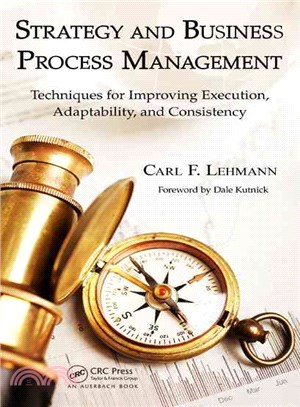Strategy and Business Process Management ─ Techniques for Improving Execution, Adaptability, and Consistency
商品資訊
ISBN13:9781439890233
出版社:Auerbach Pub UK
作者:Carl F. Lehmann
出版日:2012/03/16
裝訂/頁數:精裝/295頁
規格:24.8cm*16.5cm*1.9cm (高/寬/厚)
版次:1
定價
:NT$ 3899 元優惠價
:90 折 3509 元
無庫存,下單後進貨(到貨天數約45-60天)
下單可得紅利積點:105 點
商品簡介
作者簡介
目次
相關商品
商品簡介
This book prepares readers to master an IT and managerial discipline quickly gaining momentum in organizations of all sizes – Business Process Management (BPM). It describes how BPM treats processes as a portfolio of strategic assets that create and deliver customer and shareholder value and adapt, when necessary, enabling competitive advantage through consistent performance.Strategy and Business Process Management: Techniques for Improving Execution, Adaptability, and Consistency defines the planning framework and managerial mindset necessary to craft and drive highly effective business process improvement projects and continuous improvement programs. Readers will learn specific techniques used by industry leaders to formulate and execute business strategy that adapts organizational behavior, business processes, and information technology as a dynamic system designed to assure consistent performance and achievement, even when challenged with unexpected changes or opportunities.
作者簡介
Carl F. Lehmann is Founder & Principal Analyst at BPMethods, LLC, Duxbury, Massachusetts, USA.
目次
BEST PRACTICES USED IN STRATEGIC PLANNING
Prologue: The Management Team Is Summoned The CEO Speaks Running a Business versus Running a Business Well Using Best Practices to Align Strategy and Resources Overview of the Best Practices of Industry Leaders Using Best Practices to Innovate and Compete
How to Compete: Competitive Strategy Competitive Strategy: The Classic Approach Five Forces Model of Industry Competition New Entrants Intensity of Rivalry Pressure from Substitute Products Bargaining Power of Buyers (Customers) Bargaining Power of Suppliers Determining a Defensible Position Competitor Analysis Building on Porter’s Best Practices
How to Focus Operations: The Discipline of Market Leaders New Rules of Competition Operating Models Operational Excellence Operating ModelProduct Leadership Operating ModelCustomer Intimacy Operating ModelDefining ValueBuilding on Treacy and Wiersema’s Best Practices
How to Manage Performance: The Balanced ScorecardPerformance Measures from a Financial PerspectivePerformance Measures from a Customer PerspectivePerformance Measures from an Internal Business Process PerspectivePerformance Measures from a Learning and Growth PerspectiveStrategy MapsSummarizing Kaplan and Norton’s Best PracticesBuilding on Kaplan and Norton’s Best Practices
How to Adapt: Adaptive EnterpriseSense-and-Respond OrganizationAdaptive LoopModular OrganizationCommitment Management ProtocolBuilding on Haeckel’s Best PracticesSection I Conclusion: Strategic Planning—A Process, Not An Event
EXECUTION—BEST PRACTICE USE OF STRATEGIC RESOURCES
How to Structure Organizational Behavior for Strategic ExecutionEmpower and MotivateWorkforce CollaborationCollaborative ObjectivesManaging Responsibility and AccountabilityHow to Structure Business Processes for Strategic ExecutionDefining ProcessesOperating, Support, and Management ProcessesOperating ProcessesSupport ProcessesManagement ProcessesControl Processes and Competitive AdvantageBusiness Rules and Process ControlsCore and Noncore ProcessesPreparing to Organize Processes as AssetsManaging Processes as a Portfolio of AssetsBusiness Process Portfolio ManagementBusiness Process PortfolioBusiness Process InventoryIntroducing Business Process Reference ModelsEvaluation DimensionsNext StepsAnalyzing Inventoried ProcessesManaging Process ExecutionPerformance MeasurementSelecting Key Performance IndicatorsGeneral Rules about Selecting and Crafting KPIsMeasuring VarianceUsing Trend AnalysisUsing BenchmarkingPerformance Control via Event ManagementException Management and Resolution ManagementEnabling Event ManagementImproving Execution through Process Modeling, Analysis, and SimulationSelecting Processes for ImprovementSymptomatic versus Strategic Process ImprovementSymptomatic ProcessesStrategic ProcessesContinuous Process Improvement ProgramDealing with ComplexitySimple versus Complex ProcessesAssessing Process Complexity
How to Structure Technology for Strategic ExecutionPreparing for Process ImprovementIT Trends That Influence IT StrategyApplications and APIsWorkflow and EDIERPETLEAIBusiness Process Modeling and AnalysisBusiness Rules ManagementInternetOpen SourceSOASaaS and CloudBPMSBAM and BIAssessing IT ReadinessIT Capabilities Enabling Process ChangeOverall IT ReadinessCrafting a Process-Centric IT StrategyPetitioning for Process-Centric IT StrategyInvesting in Process-Centric IT ArchitectureIT Portfolio ManagementObjective Evaluation and Financial AnalysisObjective EvaluationFinancial AnalysisCompeting for IT BudgetIT Portfolio Budget StructureFunding AvailabilityFunding Sources and Accounting MethodsIT Budget Management: Resource PerspectiveIT Budget Management: Domain PerspectiveIT Budget Management: Purpose PerspectiveIT Budget Management: Asset Class PerspectiveIT Investment Practices of Industry LeadersMaking an IT Investment RequestSection II Conclusion: Resources Structured for Execution.
HOW TO ALIGN STRATEGY AND RESOURCES TO IMPROVE EXECUTION, ADAPTABILITY, AND CONSISTENCY
Derivative Analysis Technique for Business Strategy and Resource AlignmentDerivative Analysis DefinedUsing Derivative Analysis to Align Strategy and Resources: A Self-AssessmentA Generic Derivative AnalysisSection I: Best Practices Used in Strategic PlanningProgress Report—Section I: Best Practices Used in Strategic PlanningSection II: Execution—Best Practice Use of Strategic ResourcesProgress Report: Execution—Best Practice Use of Strategic ResourcesFinal Report: Derivative AnalysisSection III Conclusion: Strategy and Resources Aligned
Epilogue: The Management Team ReconvenesThe Chairman SpeaksSome Practical Success Factors for Improving Execution, Adaptability, and ConsistencyStart Where Common Sense Tells YouAvoid Complexity at FirstAssign OwnershipAddress MisconceptionsCommunicateCheck ReversionProceed Diligently
SUMMARY CONCLUSION
Summary of Key GuidancePrologue: Management Team Is SummonedSection I: Best Practices Used in Strategic PlanningSection II: Execution—Best Practice Use of Strategic ResourcesSection III: How to Align Strategy and Resources to Improve Execution, Adaptability, and ConsistencyEpilogue: Management Team ReconvenesAppendix A: Important TerminologyAppendix B: How to Evaluate Business Process Analysis SoftwareWorks CitedIndex
Prologue: The Management Team Is Summoned The CEO Speaks Running a Business versus Running a Business Well Using Best Practices to Align Strategy and Resources Overview of the Best Practices of Industry Leaders Using Best Practices to Innovate and Compete
How to Compete: Competitive Strategy Competitive Strategy: The Classic Approach Five Forces Model of Industry Competition New Entrants Intensity of Rivalry Pressure from Substitute Products Bargaining Power of Buyers (Customers) Bargaining Power of Suppliers Determining a Defensible Position Competitor Analysis Building on Porter’s Best Practices
How to Focus Operations: The Discipline of Market Leaders New Rules of Competition Operating Models Operational Excellence Operating ModelProduct Leadership Operating ModelCustomer Intimacy Operating ModelDefining ValueBuilding on Treacy and Wiersema’s Best Practices
How to Manage Performance: The Balanced ScorecardPerformance Measures from a Financial PerspectivePerformance Measures from a Customer PerspectivePerformance Measures from an Internal Business Process PerspectivePerformance Measures from a Learning and Growth PerspectiveStrategy MapsSummarizing Kaplan and Norton’s Best PracticesBuilding on Kaplan and Norton’s Best Practices
How to Adapt: Adaptive EnterpriseSense-and-Respond OrganizationAdaptive LoopModular OrganizationCommitment Management ProtocolBuilding on Haeckel’s Best PracticesSection I Conclusion: Strategic Planning—A Process, Not An Event
EXECUTION—BEST PRACTICE USE OF STRATEGIC RESOURCES
How to Structure Organizational Behavior for Strategic ExecutionEmpower and MotivateWorkforce CollaborationCollaborative ObjectivesManaging Responsibility and AccountabilityHow to Structure Business Processes for Strategic ExecutionDefining ProcessesOperating, Support, and Management ProcessesOperating ProcessesSupport ProcessesManagement ProcessesControl Processes and Competitive AdvantageBusiness Rules and Process ControlsCore and Noncore ProcessesPreparing to Organize Processes as AssetsManaging Processes as a Portfolio of AssetsBusiness Process Portfolio ManagementBusiness Process PortfolioBusiness Process InventoryIntroducing Business Process Reference ModelsEvaluation DimensionsNext StepsAnalyzing Inventoried ProcessesManaging Process ExecutionPerformance MeasurementSelecting Key Performance IndicatorsGeneral Rules about Selecting and Crafting KPIsMeasuring VarianceUsing Trend AnalysisUsing BenchmarkingPerformance Control via Event ManagementException Management and Resolution ManagementEnabling Event ManagementImproving Execution through Process Modeling, Analysis, and SimulationSelecting Processes for ImprovementSymptomatic versus Strategic Process ImprovementSymptomatic ProcessesStrategic ProcessesContinuous Process Improvement ProgramDealing with ComplexitySimple versus Complex ProcessesAssessing Process Complexity
How to Structure Technology for Strategic ExecutionPreparing for Process ImprovementIT Trends That Influence IT StrategyApplications and APIsWorkflow and EDIERPETLEAIBusiness Process Modeling and AnalysisBusiness Rules ManagementInternetOpen SourceSOASaaS and CloudBPMSBAM and BIAssessing IT ReadinessIT Capabilities Enabling Process ChangeOverall IT ReadinessCrafting a Process-Centric IT StrategyPetitioning for Process-Centric IT StrategyInvesting in Process-Centric IT ArchitectureIT Portfolio ManagementObjective Evaluation and Financial AnalysisObjective EvaluationFinancial AnalysisCompeting for IT BudgetIT Portfolio Budget StructureFunding AvailabilityFunding Sources and Accounting MethodsIT Budget Management: Resource PerspectiveIT Budget Management: Domain PerspectiveIT Budget Management: Purpose PerspectiveIT Budget Management: Asset Class PerspectiveIT Investment Practices of Industry LeadersMaking an IT Investment RequestSection II Conclusion: Resources Structured for Execution.
HOW TO ALIGN STRATEGY AND RESOURCES TO IMPROVE EXECUTION, ADAPTABILITY, AND CONSISTENCY
Derivative Analysis Technique for Business Strategy and Resource AlignmentDerivative Analysis DefinedUsing Derivative Analysis to Align Strategy and Resources: A Self-AssessmentA Generic Derivative AnalysisSection I: Best Practices Used in Strategic PlanningProgress Report—Section I: Best Practices Used in Strategic PlanningSection II: Execution—Best Practice Use of Strategic ResourcesProgress Report: Execution—Best Practice Use of Strategic ResourcesFinal Report: Derivative AnalysisSection III Conclusion: Strategy and Resources Aligned
Epilogue: The Management Team ReconvenesThe Chairman SpeaksSome Practical Success Factors for Improving Execution, Adaptability, and ConsistencyStart Where Common Sense Tells YouAvoid Complexity at FirstAssign OwnershipAddress MisconceptionsCommunicateCheck ReversionProceed Diligently
SUMMARY CONCLUSION
Summary of Key GuidancePrologue: Management Team Is SummonedSection I: Best Practices Used in Strategic PlanningSection II: Execution—Best Practice Use of Strategic ResourcesSection III: How to Align Strategy and Resources to Improve Execution, Adaptability, and ConsistencyEpilogue: Management Team ReconvenesAppendix A: Important TerminologyAppendix B: How to Evaluate Business Process Analysis SoftwareWorks CitedIndex
主題書展
更多
主題書展
更多書展今日66折
您曾經瀏覽過的商品
購物須知
外文書商品之書封,為出版社提供之樣本。實際出貨商品,以出版社所提供之現有版本為主。部份書籍,因出版社供應狀況特殊,匯率將依實際狀況做調整。
無庫存之商品,在您完成訂單程序之後,將以空運的方式為你下單調貨。為了縮短等待的時間,建議您將外文書與其他商品分開下單,以獲得最快的取貨速度,平均調貨時間為1~2個月。
為了保護您的權益,「三民網路書店」提供會員七日商品鑑賞期(收到商品為起始日)。
若要辦理退貨,請在商品鑑賞期內寄回,且商品必須是全新狀態與完整包裝(商品、附件、發票、隨貨贈品等)否則恕不接受退貨。
























